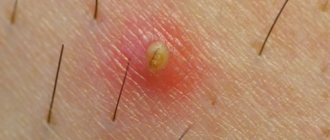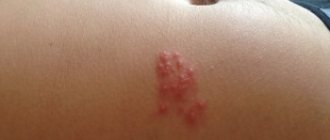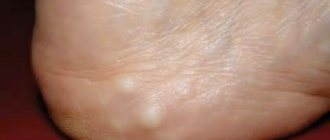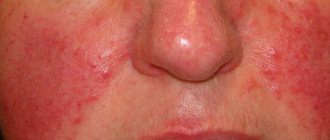Cyst on the penis: causes, symptoms and methods of elimination
Cystic formation on the penis is a widespread phenomenon.
However, at the initial stage of pathology, people often do not seek help from a specialist, waiting for alarming symptoms indicating the development of an inflammatory process or suppuration.
A lump on the genitals is fraught with serious discomfort and dangerous complications, so it is important to know the provoking factors of the disease.
What is a cyst on the penis?
Atheroma is a benign that occurs due to clogging of the sebaceous glands. In a similar scenario, whiteheads develop on the face. Lipoma can form in any part of the body where glands are present. Often a cyst is mistaken for a wart or papilloma, which is caused by HPV.
Most people are infected with the virus. The formation of dense defects on the genital organ occurs due to decreased immunity. Viral tumors are dangerous due to infection and malignant degeneration.
Minor cysts are asymptomatic and go away on their own. These lipomas often appear in middle age. The wen itself looks like a small pimple or polyp. Inside the capsule there is white or yellow content, consisting of accumulated stagnant secretion of the gland, epithelial and fat cells.
A penis cyst is not an infectious pathology that is not transmitted through sexual intercourse. In most cases, atheroma is not dangerous, but sometimes the wen becomes inflamed or filled with pus.
Causes
Lipoma on the genitals in men develops due to:
- Improper shaving of the intimate area, use of a razor. Such a blade often damages the delicate skin, which can also lead to infection.
- Failure to comply with personal hygiene rules, using someone else's toothbrush, towel, comb.
- Hormonal imbalance. Atheroma appears especially often in adolescents due to excessive testosterone production.
- Increased sweating in the groin area, resulting in blockage of the sweat and sebaceous glands.
Wen also occurs due to wearing tight trousers and tight underwear. Depilation and piercing often injure the sebaceous glands, which also provokes the appearance of pathology.
Clinical manifestations
Cysts less than one centimeter almost always do not cause discomfort . An increasing atheroma makes itself felt by a noticeable dense tubercle that does not cause pain upon palpation. In the absence of an inflammatory process, the skin over the defect is smooth.
If an infection has entered the wen, the patient begins to suffer from severe itching, mild pain, redness of the epithelium around the formation, and increased temperature of the affected area.
Lack of timely treatment leads to significant swelling of tissue structures, severe pain, and hyperemia. At the same time, pathogenic microorganisms also infect other organs of the reproductive system.
The process of suppuration is dangerous due to the formation of an abscess. If the lipoma progresses well, it can open on its own, releasing a capsule with its contents.
Diagnostics
A penile cyst is easily diagnosed, without the use of hardware and laboratory research methods. An experienced specialist is able to establish an accurate diagnosis even during an external examination of the affected organ.
In this case, the doctor is obliged to exclude diseases that are similar in symptoms, for example, Peyronie’s disease with dense scars on the skin of the penis, lymphangitis with chronic inflammatory damage to the lymph nodes, smegmolitis with a pathological process in the head and foreskin due to deterioration of the outflow of secretions, allergic reactions, benign sebaceous gland adenoma .
Lipoma can recur, so it is important to identify the true cause, the provoking factor for the development of the wen.
Treatment methods
Atheroma is a non-lethal disease that rarely worsens the general condition of the body. If the formations are small in size, there are no unpleasant sensations, or an inflammatory process, only periodic observation by a specialist is required without surgical intervention.
If redness appears and purulent contents begin to be released, the cyst should be removed immediately. In this case, elimination of the pathological formation does not require hospitalization. The gland duct is drained, followed by curettage of the capsule.
The classic operation is performed under local anesthesia. During standard surgery, the capsule is opened to allow free release of purulent contents. After this, the cavity is treated with an antiseptic solution, and the body of the cyst is removed.
The rehabilitation period consists of treating the wound with special ointments and antiseptics. Antibiotics are not prescribed in this case.
If the atheroma is not inflamed, but causes only cosmetic discomfort, then electrical destruction or radio wave method is used to eliminate the problem. These two modern methods of getting rid of a wen on the penis are indicated only for small lesions and are done under local anesthesia.
Possible complications
Self-treatment is contraindicated, because in rare cases a cyst leads to serious consequences, such as:
- Abscess.
- Phlegmon.
- Penetration of pathogenic microorganisms into the lipoma cavity.
- Infection of neighboring tissues.
- Repeated accumulation of purulent contents after its elimination at home.
- Penetration of pus into the tissue under the skin.
Some of the complications can cause significant harm to the sexual organ and the entire body, so you should not self-medicate.
Forecast
The prognosis for wen of the genital organ is very favorable. If the atheroma is small, not inflamed, and does not cause discomfort, then removal of the formation is not carried out. Instead, the patient should be periodically examined by an experienced specialist to evaluate the pathology.
If there is an inflammatory process, discharge of purulent contents, or pain, the lipoma should be removed immediately, otherwise infection and the development of an abscess are possible. In severe and advanced cases, even amputation of the organ is possible, so you should not engage in independent treatment or squeeze out the purulent contents.
A cyst on the penis is a common condition that most often occurs in adolescence or middle age. In young men, lipoma appears due to hormonal disorders and increased testosterone production. This occurs during puberty.
When this period ends, the atheroma often resolves on its own. In other cases, the occurrence of a neoplasm in the intimate area indicates a blockage of the duct of one of the sebaceous glands or mechanical damage to the delicate epithelium during shaving with a razor.
To prevent clogging, it is necessary to observe the rules of personal hygiene and avoid the use of ordinary soap. Instead, wash the penis and scrotum with special gels. If a cyst appears, you must consult a doctor promptly, without waiting for alarm signals.
Source: https://onkologia.ru/dobrokachestvennyie-opuholi/mochevydelitelnaya-sistema/kista-na-chlene/
Inflammation of the hair follicles on the male genitals. Folliculitis of the scrotum
Genital folliculitis in men is a inflammation at the location of the hair follicle. The disease can be of fungal, microbial and viral origin.
First, a small red spot appears on the skin. Or a dense knot forms around the hair. After some time, such formations turn into pustules. In the future, they can open up and dry out on their own.
Often several pustules “join” into one abscess. Such formations can cover large areas of the skin and turn into boils. They can be dangerous for men and require immediate treatment by a specialized specialist. Treatment of this form of folliculitis is quite complicated.
Causes of folliculitis on the genitals
Among the reasons why hair follicles become inflamed and folliculitis most often appears in the groin are the following:
- Failure to comply with personal hygiene rules;
- Friction of the skin against the folds of clothing;
- Dissection and microcracks in the skin with characteristic itching ( harbingers of the possible occurrence of folliculitis in the groin );
- As a result of incorrectly installed compresses;
- For excessive sweating.
Folliculitis in the groin is accompanied by skin itching, redness and quite painful sensations in the affected area. Such manifestations in men occur on the scrotum, penis, pubis and inguinal folds.
A hair follicle on the penis may appear for the reasons already listed, but additional etiologies include the following factors:
- The presence of a fungal infection;
- Syphilis, gonorrhea ;
- Inflammation of the hair follicle due to ingrown hair on the scrotum;
- Scabies or demodectic mites;
- Folliculitis in the groin as a consequence of the herpes virus;
- The presence of molluscum contagiosum or herpes zoster in a man;
- Inflammation in the groin after skin damage (scratches, cuts);
- After scratching in the groin area and on the scrotum;
- Long-term (chronic) allergies, itchy skin or manifestations of dermatitis in the groin .
Indirect causes of folliculitis in the groin are previous infectious diseases of the oral cavity (gingivitis, caries, periodontal disease). Also chronic forms of tonsillitis and pharyngitis.
Hair follicles appear in immunodeficiency. This phenomenon occurs when using hormonal ointments. And also when tissues are irritated by certain substances or household chemical residues directly on the body or on clothing.
Types of folliculitis
More often, folliculitis has a simultaneous manifestation (multiple abscesses) on a certain area of the scalp. Folliculitis in the groin is accompanied by pain and itching. In the absence of proper treatment and hygiene, the disease becomes more complicated.
In medicine, scrotal folliculitis is divided into several types:
- Staphylococcal folliculitis in the groin sometimes becomes complicated by the development of sycosis;
- Pseudomonas or popularly - “disease from a hot bath” (the reason for its appearance follows from this name);
- Syphilitic folliculitis in the groin (appears during secondary infection with syphilis);
- Gonorrheal folliculitis is a complication from a long course of a disease with an identical name, or in the absence of therapy (frequent localization in men is the hair follicle on the penis, the groin area);
- Candidal folliculitis ;
- Dermatophytic folliculitis in the groin begins with inflammation on the surface of the skin (stratum corneum), over time it covers the hair follicles and shafts (After treatment, scars often remain);
- Herpetic folliculitis on the scrotum resolves with the formation of vesicles;
- Folliculitis in the groin, as a result of demodicosis (symptoms are redness and the appearance of pustules with peeling of the skin around);
- Impetigo Bockhart is a type of folliculitis, including in men in the groin (appears when the skin softens from overheating with compresses, excessive sweating).
Who is most susceptible to folliculitis?
Folliculitis , including in the groin, can often be detected in the presence of the following factors accompanying its development:
- Unsanitary conditions;
- Neglect of hygiene standards;
- Promiscuous sexual intercourse;
- Communication with disadvantaged people (in case of inappropriate living conditions, food, body care);
- Excessively hot living climate (increased risk of getting folliculitis on the skin);
- People working with flammable substances (permanently or for a long time), lubricating oils;
- Patients diagnosed with diabetes mellitus;
- A certain chemical composition of sweat (as a concomitant factor);
- For immunodeficiency, long-term vitamin deficiency.
Complications caused by folliculitis
Hair follicles, after a period of inflammation, are usually completely curable. Sometimes scars may remain at the site of tissue healing.
More often, inflammation of the hair follicle occurs without complications for the patient’s body. Only in some cases do certain problems arise in men after folliculitis in the groin. Reasons for this:
- Lack of hygiene;
- Unqualified provision of therapy.
As a result, neoplasms of a more complex nature appear than the hair follicles themselves:
- Carbuncles and abscesses of various sizes;
- Follicular scars on the surface of the skin;
- Dermatophytosis.
Sometimes untreated formations of this type can cause meningitis and pneumonia in the patient in the near future.
What are the symptoms of folliculitis?
Hair follicles develop until the inflammation resolves naturally (drying out or opening) on average for one week. More often, after treatment and complete healing of the abscess, not even a trace remains of it.
After opening the folliculitis in the groin and releasing purulent masses, sometimes an ingrown hair, a small ulcer remains. It is covered with a crust of blood and pus residue. If the entire follicle is affected during the course of the disease, then after removing the crust, a scar will remain on the surface of the scrotum, and the color of the skin around it will change.
Diagnosis of genital folliculitis
The main function of a urologist in diagnosing folliculitis in the groin is to differentiate the disease from the infectious nature of its origin. It is necessary to clearly distinguish this variety from others that can infect hair follicles.
When determining an accurate diagnosis, you should :
- Take into account the entire clinical “picture”;
- Collect anamnesis (information about possible predisposing factors);
- Conduct various types of laboratory tests;
- Undergo bacterial culture;
- Blood test (to determine glucose levels, rule out diabetes);
- Skin biopsy (in some cases).
To correctly diagnose folliculitis on the surface of tissues, including in the groin, it is important to study the nature of the rash. The resulting “picture” of abscesses will show a qualified specialist the right path to establishing the exact cause of folliculitis in the groin. This will make it possible to quickly find the source of inflammation and qualitatively eliminate the etiology of the disease.
How to treat folliculitis
Therapy for folliculitis begins with a detailed examination of the patient’s skin lesions by a urologist. All subsequent actions are carried out after a detailed study of the history of the disease, test results, using extensive experience in the field of urology.
Therapy must necessarily correspond to the etiology:
- After identifying folliculitis in the groin of bacterial origin, a certain antibiotic-based ointment is prescribed;
- For fungi - antifungal drugs;
- acyclovir is ideal .
At the initial stage, treating the affected areas with a more suitable solution will be sufficient. Systemic therapy is necessary only in severe, advanced conditions or relapses of folliculitis.
To prevent the infection from spreading further through the tissues, it is better to apply alcohol-based treatment around the abscesses. Ultraviolet radiation is often additionally prescribed.
The staphylococcal variety requires taking: cephalexin, erythromycin, dicloxacillin. Severe forms can be cured with the use of ciprofloxacin. It is advisable to prescribe fluconazole or itraconazole for candidiasis. And terbinafine - for dermatophytes.
In cases where an immunodeficiency state or diabetes is detected in a patient, their simultaneous therapy along with folliculitis is necessary.
Prevention of folliculitis, doctor's advice
Prevention of folliculitis in the groin includes many measures and precautions:
- Constant hygiene (this way the hair follicles will never become infected);
- Timely and, of course, proper care for your own skin, as well as hair (minimizes the likelihood of folliculitis in the groin);
- Skin injuries should be avoided;
- At every opportunity, try to wear loose clothing and underwear that does not overly compress the surface of the skin (otherwise the hair follicles are easily damaged).
Our clinic specializes in urological diseases. Today, working in Ukraine (Nikolaev), our specialists regularly attend advanced training courses in countries with more developed medicine. This makes it possible to improve your own knowledge and gain advanced experience, and study treatment technologies.
Folliculitis will not become a big problem for you if you contact our clinic in Nikolaev in a timely manner. Come for your consultation on time. We guarantee anonymity and professional support.
Source: https://www.urologist.com.ua/urologiceskie-zabolevaniya/follikulit-moshonki/
Atheroma on the scrotum and penis: removal, treatment, complications
Benign formations of the male reproductive system include cavities that change the shape of the genital organs and cause superficial or internal deformation.
The most common pathology of this type is a cyst in the scrotum, penis and epididymis. These formations can be combined with an infectious course.
The appearance of cysts in most cases occurs in men aged 30-60 years.
The appearance of atheroma in most cases occurs in men aged 30-60 years.
Tumor and skin cysts are classified. The first include cavities that form inside the genital organs.
They have an elastic structure, their walls do not extend outside the cover.
A skin cyst on the penis or in another area is often accompanied by a violation of the upper skin layer, its walls are noticeably separated from the internal tissues.
Causes
Cysts of the penis or scrotum appear due to trauma to the genital organs or blockage of the sebaceous glands.
- Poor hygiene when shaving, using low-quality or dull razors.
As the blades become unusable, they microscopically damage the skin of the genital organs. In this place, ichor and plasma particles accumulate, which subsequently become infected. In this way, atheroma develops on the penis. Poor hygiene when shaving. - The most common cause of genital cysts is clogging of the sebaceous glands.
Excessive fat secretion leads to narrowing or complete blocking of the excretory duct. If hair growth is observed in this area, then the follicles are involved in the process. They rupture from excess fat accumulation, and a cavity or atheroma of the scrotum forms around the source of inflammation. Clogging of the sebaceous glands leads to the formation of atheroma.
Benign neoplasms of the external type sometimes appear during puberty, when there is an active release of sex hormones. And internal tumors of the urinary system naturally appear after a decrease in sexual activity and the development of congestive processes in the penis.
The risk of atheroma in the groin in men increases significantly if he wears tight underwear made from non-natural fabrics.
Excessive sweating occurs in this area. Gradually, minor depressions form in the groin or scrotal area, into which the product of the sebaceous glands enters. The greatest danger is posed by an infected cyst, where the active development of pathogenic microflora occurs.
Symptoms and possible localization
The manifestations of the tumor depend on what type of course it has and where it is localized.
- Atheroma of the scrotum. The patient exhibits round, elastic formations. There is no pain in 80%. The atheroma adheres to neighboring tissues, and a black dot is observed inside the formation. When suppuration occurs, the surface of the capsule turns red, becomes painful, and an infected secretion from dark green to brown can be released from the surface.
- Atheromas of the penis. A dense capsule appears on the shaft or head of the penis. It causes severe itching, but in the absence of infection it does not change color. During the inflammatory process, the skin bulges and its temperature rises. The penis swells and turns red. There is a high probability of self-opening of penile atheroma while wearing underwear.
The left or right testicle is deformed.
- Testicular cyst (right and left epididymis). At the early stage there are no signs, the capsule is no larger than a pea. It is difficult to determine the formation by palpation. As the tumor grows, pressure occurs on the seminal duct, and the left or right testicle becomes deformed. Pain and a feeling of squeezing appear in the abdominal area. During sexual intercourse, severe discomfort occurs.
Why is a sebaceous gland cyst in the genital area dangerous?
When infected, atheroma of the scrotum or other cysts pose a great danger. Suppuration occurs in 75% of men, the pathological process is accompanied by fever and severe pain.
The most dangerous type of infection occurs with atheroma of the penis, when pathogenic organisms enter the vessels of the penis.
Systemic damage can cause deterioration in general condition, severe itching with pain and fever.
Severe itching with pain and fever occur.
A cyst of the spermatic cord also has negative consequences. Spermatocele is formed from seminal fluid. If it accumulates excessively, the capsule can reach 5 cm. This provokes rupture of the walls and spillage of the contents into the scrotum.
Swelling and inflammation can reach the second testicle, which increases the likelihood of developing infertility.
Diagnostic methods
Diagnosis or treatment of cysts on the genital organs is carried out by a dermatovenerologist and surgeon, if there are indications for surgical intervention.
- The area of the testicles and scrotum is palpated to determine the location of the cavity.
- If an internal cyst is suspected, an ultrasound scan is performed.
This will allow you to determine the size of the capsule and its exact location. Ultrasound helps determine the size of the capsule and its exact location. - A testicular cyst is determined using diaphanoscopy. Using the method, the bag is transilluminated.
- If the course of the pathology is not clear, an additional MRI is performed.
Treatment of atheromatosis
Self-medication for atheroma is unacceptable; at home it is difficult to remove residual cyst tissue after its breakthrough. Without medical intervention, there is a high probability of recurrence of the pathology and suppuration. Only surgical intervention guarantees a complete cure for atheroma. If suppuration occurs, urgent hospitalization is required.
- Classic removal. An incision is made in the capsule area with a scalpel. The cyst is enucleated, separated from nearby tissues and the wound is sutured. The stitches are removed after a while.
Atheroma peeling. Laser removal.
- Laser. Used for the removal of atheromas and spermatoceles as an effective and bloodless method. The cyst undergoes destruction, the contents evaporate. After surgery there is no scar.
- Radio waves. Used only for cutaneous cysts to burn out pathological tissue.
Treatment of cyst-atheroma is carried out under local anesthesia; the duration of the operation without complications does not exceed 30 minutes.
Treatment of testicular cysts with sclerotherapy occurs through filling the cavity with a special substance. It replaces the contents of the capsule and glues its walls. The introduction of a sclerosant is permissible in extreme cases; this type of operation can lead to infertility.
Possible consequences
The most common consequence of atheromas and cysts of the genital organs in men is considered to be their infection. Systemic inflammation is dangerous to overall health. In young men, the spread and deepening of pathogenic organisms increases the risk of reducing the ability to further conceive.
The risk of decreased ability to conceive further increases.
Cellulitis may occur at the site of atheroma. In this case, the capsule melts under the action of pus, which spills deep into the tissue. An abscess can cause damage to nearby vessels, which will lead to the spread of infection throughout the circulatory system.
One of the rare consequences of cysts in men on the genital organs is their degeneration into a malignant tumor. This can happen after an unsuccessful attempt to remove the cavity on your own, when its particles remain under the skin.
Prevention of occurrence
Atheromas are associated with blockage of the sebaceous glands, so if pathology occurs, a man needs to control his diet. You will need to eliminate fatty foods. It is recommended to carefully observe intimate hygiene and remove sweat from the external genital area.
If strange formations are detected outside or inside the genital organs, it is recommended to consult a therapist and undergo instrumental diagnostics. The sooner a cyst is detected, the fewer complications it can cause.
Source: https://kistateka.ru/tkani/ateroma-na-moshonke-i-chlene
Pathology treatment methods
Treatment of blockage of the sebaceous gland with drugs, at the present stage of medical development, is ineffective. You can only eliminate the lump temporarily, but later it may appear again in the same place or nearby. Therefore, surgical treatment is used to combat pathology.
Traditional operation
It is performed under local anesthesia, and hospitalization is usually not necessary. The indication for surgery is the patient's wishes or the achievement of a large size of the lump.
Typically, the doctor makes an incision at the top of the lump, squeezes out the contents and collects it with a sterile napkin. Then the capsule is carefully removed. The choice of technique depends on the preferences of the doctor and the wishes of the patient. If it is necessary to achieve a cosmetic effect, sutures are placed on the subcutaneous tissue and skin.
Laser treatment
Laser removal is used at the early stage of sebaceous gland blockage. The essence of the method is to expose the problem area of the skin to a laser beam. Under its action, the affected cells evaporate, so it is possible to achieve the disappearance of the cyst without the formation of scars.
The operation is performed under local anesthesia and lasts no more than 15 minutes. After 5 days, the patient completely forgets about the pain caused by skin damage.
Photodynamic treatment and impact on the lump using electrocoagulation have similar indications and principles.
Wen on the genitals in men
Men worry about their health no less than women. Personalities of the stronger sex do not run to the doctor at the first pimple, but nevertheless worry if formations appear on the genitals. Characteristic signs of STDs, HPV, atheromas and omentums force a man to consult a urologist or dermatovenerologist.
The appearance of oil seals on the penis
Changes in the penis cause anxiety among males. Omentums appear in men aged 30-35 years. The disease is not dangerous and not contagious, but whitish or yellowish detections lead to panic.
At first, there is no reason to worry about pimples. The disease at its initial stage can be easily treated at home. In advanced cases, you need to consult a surgeon who will make a decision regarding the wen.
Sediment glands are a skin condition in men. On the genital organ and the hairy membrane, white dots appear in the form of pimples of different sizes with white secretion and pus when squeezed out, the size of which does not exceed 2 mm.
Acne appears several at once or one at a time, developing all the time or in episodes. The head of the penis has thick skin, so the problem is only noticeable there. In addition, elements called papules form in the mouth, chest and groin. Seborrheic cysts form multiple times.
Upon palpation, the man does not feel pain. When pressed, lipids are released from the secretory organ into the blood. This area of skin then turns red and becomes a hematoma. Doctors do not advise pressing or picking at the epidermis. The disease is not transmitted by airborne droplets or sexually.
The inconvenience is that the man is not confident in himself and feels discomfort in front of his chosen one.
Reasons that influence tissue clogging:
- A young man shaves incorrectly using a razor.
Cosmetologists do not recommend using a razor to avoid getting sick. The edge of the machine quickly becomes unusable, thereby injuring delicate skin. Sores and ulcers are a source of development of infectious diseases on the skin. Blocked sebaceous glands are considered an infection. - The man does not comply with individual norms and rules.
We should not forget that using someone else’s towel, personal hygiene products - toothbrush, comb, and rarely taking a bath negatively affects a person. Due to the presence of fat accumulated in organs consisting of secretory cells, the pores become clogged and white pimples appear. - Presence of hormonal dysfunctions.
Boys often suffer from this problem during adolescence. Rashes appear on the skin, even on the penis. Nothing wrong with that. When puberty comes to an end, the omentums will disappear. - There are problems with the urethra. Often a pathogenic environment becomes the basis for inflammation. If you damage the skin on the penis, microbes will settle where the wound appears. Skin cells die. The wound is festering.
The disease occurs in young people whose immune systems are weak and prone to infection. The affected areas become dense, red, and grow. Pain is noted when pressed. Purulent contents with bleeding nodules appear. You cannot press, otherwise the infection will spread and the process will be difficult.
If the boy has been circumcised, such problems do not arise. This indicates that a large amount of smegma negatively affects men's health.
Problems and symptoms of diseases
In men, the glandular cells located on the penis carry out their work as expected. Without a mixture of fat-like substances, the skin on the penis would be dry and cracked. The skin glands become clogged and acne appears, without negatively affecting the epidermis on the penis and testicles.
The seals on the penis have different shapes and colors. It depends on the causes of inflammation.
- Round reddish pimples with white pus inside acne or cyst. Formed in the absence of personal hygiene, they are easily treated. A cyst on the penis is a dangerous disease with walls and a cavity. Inside there is a purulent mass, which can be removed through surgery.
- Small whitish formations occur when the hair follicle is damaged. Oil is produced by the sebaceous gland, on the surface of which there is a hole for the release of sebum onto the skin. When clogged, skin secretions accumulate in the gland. Picking and removing without the help of a doctor is not recommended. The infection penetrates the glandular tissue and the pimple becomes inflamed.
- Water bubbles located at the head of the penis. Papules form due to hormonal changes. Testosterone is typical for a man, thanks to which secondary sexual characteristics are formed. The hormone is produced during adolescence, and the work of the sweat glands is activated. The skin is sweaty. If a young person wears synthetic tight underwear, moisture in the groin increases. Indentations form on the skin where sebaceous secretions flow. Papules are not removed or squeezed out. If a pimple breaks out, pathogenic organisms will enter the wound.
- Sores containing brown or green color are indicators that a man has viruses in his body that are transmitted during sex: chlamydia, ureaplasma, herpes, which are treated under the supervision of a doctor.
Hidden under seborrheic cysts are:
- Molluscum contagiosum - round marble or pearlescent pimples.
- Chronic dermatosis - white nodules with itching.
- Inflammatory chronic skin disease - itches and burns.
- A disease of the neurogenic-allergic type—severe unbearable itching, especially at night.
In order to make sure that Fordyce granules do not need to be treated, they go to a dermatovenerologist. Non-inflamed cysts do not bother a man. But as soon as the disease takes on a different character, this becomes the reason for contacting a doctor, who will identify the causes and begin to treat the patient.
In addition, women are afraid to have sexual intercourse with a man with cysts, believing that this is a venereal disease.
Treatment of Fordyce granules
If the hormonal levels return to normal, the disease will go away on its own, without medical intervention, in the absence of therapy. When infected, antibiotics are used. Antibacterial drugs are prescribed locally and orally.
It is suggested to remove seborrheic cysts using electric current or grinding. The man will get rid of the deficiency, but recurrences of the disease appear again. The use of creams with retin-A shows the effectiveness of the application.
Scientists have not figured out for sure where the disease comes from. It is known that the disease goes away by the age of 40.
Clogging of skin glands
Similar to Fordyce granules, but the pores become clogged on the penis on the sebaceous gland. The condition does not require treatment. The orifices become contaminated in teenage boys or young adults who are prone to immune diseases or endocrine disorders.
Males want to remove clogged pores on their own, rarely using an antiseptic. Infection and sepsis occur. There is no need to put off going to the doctor to get rid of a cosmetic defect.
Atheromatosis in men and what is a cyst on the penis
Atheroma on the penis is a benign formation, similar to a pathological capsule with adipocytes and particles of white or yellow epithelial tissue. Tumors are localized on the head, genitals, groin area and areas covered with hair. Cysts up to 5 cm in size open on their own and do not cause concern. Tumor formation:
- not an infectious disease;
- it is impossible to become infected during sex;
- does not harm a man, but affects infection and inflammatory processes
When the lipoma reaches 10 mm:
- the lump does not hurt;
- the epidermis is not damaged, the color is not changed;
- itches;
- the skin in the area of the seal is warmer than in other places;
- the vessels are filled with blood, infections spread to the scrotum and groin, the development of purulent inflammation
Atheromas do not threaten human life. It is not recommended to touch non-inflamed sebaceous cysts. In the case of a pathological process, the wen is removed on an outpatient basis.
Methods for treating wen:
- The lipoma is removed under local anesthesia in a medical facility. Open the capsule, remove the purulent mass using an antiseptic.
- If there is aesthetic discomfort, the cyst can be removed using radio waves. The procedure is carried out under sterile conditions.
Complications of tumor formations
- Abscesses
- Purulent inflammation of soft tissues
- Infection of an opened lipoma
- Recurrence of pus accumulation
- Output of purulent exudate
Diagnosis of cysts
The patient is examined and the causes of the formation of sebaceous tumors are identified. For this purpose they rent:
- blood for hormones. If testosterone and estradiol are increased, treatment with hormonal drugs will be used
- urine. Protein in the urine indicates the presence of inflammatory processes
- sebaceous secretion, which is collected in a special-purpose bowl. After one week, observe and study whether the number of bacteria has increased.
It is necessary to take antibacterial medications in order to recover.
Treatment of cystic tumors in men
Based on the appearance of omentums, the doctor selects treatment: local drugs, antibiotics, resection.
Local treatment is allowed at home. They buy an antiseptic - chlorhexidine or miramistin - and treat the sebaceous gland, having first cleansed the skin on the penis. The glands are washed with hydrogen peroxide, the sequence of actions is repeated twice a day. Apply cream with jojoba oil.
Preventive actions
- Using your own towel
- Shaving exclusively with special means
- When bathing, use antibacterial gel and soap
A man is obliged to carefully monitor his health, especially his manhood. If pathological features are detected, it is important to contact a urologist as soon as possible to avoid irreversible consequences.
Source: https://kistayaichnika.ru/klassifikaciya/kista-na-chlene.html
Why is a sebaceous gland cyst in the genital area dangerous?
When infected, atheroma of the scrotum or other cysts pose a great danger. Suppuration occurs in 75% of men, the pathological process is accompanied by fever and severe pain.
The most dangerous type of infection occurs with atheroma of the penis, when pathogenic organisms enter the vessels of the penis.
Systemic damage can cause deterioration of the general condition, severe itching with pain and fever.
A cyst of the spermatic cord also has negative consequences. Spermatocele is formed from seminal fluid. If it accumulates excessively, the capsule can reach 5 cm. This provokes rupture of the walls and spillage of the contents into the scrotum.
What reasons influence the formation of pimples?
When exposed to various factors, the sebaceous glands become clogged. A white pimple with dense contents appears on the affected area of the skin. It is not recommended to squeeze or pick it out. The reasons that influence the blockage of the glands are varied. Experts identify several main factors:
- Improper shaving;
- Violation of personal hygiene rules;
- Hormonal disbalance;
- Inflammatory diseases of the urethral canal.
Improper shaving is one of the most common causes of glands on the penis. Many men use a regular razor for shaving. This is not worth doing. For depilation of various areas of the body, stores offer a large selection of different products. The blades of the machine can quickly become dull and cause microtrauma to delicate skin. These wounds become a source of various infections of the epidermis. One of them is clogging of the seals.
Violation of personal hygiene rules leads to various health problems. If a man uses someone else’s towel, a common body wash, and rarely takes a bath, then the oil from the skin is poorly washed off. Fat accumulates in the glands and clogs them. This leads to the formation of white pimples.
Hormonal imbalance affects the condition of the sebaceous glands in boys during adolescence. Many teenagers notice the formation of various rashes on the body, including on the penis area. This is not a pathology. The period of hormonal adjustment will end, and the omentums will disappear on their own.
Inflammatory diseases of the urethral canal lead to various infections of the skin of the penis. The cause of inflammation is most often a pathogenic microorganism. If there are various lesions on the skin of the penis, the microbe can settle on the wound surface. It causes necrosis of epidermal cells. Dead cells accumulate in the glands and suppuration occurs.
Therapy is selected by the doctor depending on the causes of omentum formation. Treatment can be divided into the following methods:
- Local exposure to drugs;
- Antibiotic therapy;
- Laser removal or electrocoagulation.
Cyst on the penis: atheromatosis, seborrheic tumor, treatment of wen
Typically, atheromas (also called wen), which are benign formations, are found on the penis of men. The main reason for their occurrence is blockage of the sebaceous gland duct.
In principle, such formations can appear on various areas of the skin - wherever such ducts are present. And sebaceous glands are found throughout the body, but most of them are concentrated on the face, neck and back.
Many such ducts are also found in the genital area.
In men, small cysts are very often present in the genital area. And doctors tend to consider this condition as a variant of the norm if the size of the formations does not increase.
Why is a sebaceous gland cyst in the genital area dangerous?
When infected, atheroma of the scrotum or other cysts pose a great danger. Suppuration occurs in 75% of men, the pathological process is accompanied by fever and severe pain.
The most dangerous type of infection occurs with atheroma of the penis, when pathogenic organisms enter the vessels of the penis.
Systemic damage can cause deterioration in general condition, severe itching with pain and fever.
A cyst of the spermatic cord also has negative consequences. Spermatocele is formed from seminal fluid. If it accumulates excessively, the capsule can reach 5 cm. This provokes rupture of the walls and spillage of the contents into the scrotum.
Swelling and inflammation can reach the second testicle, which increases the likelihood of developing infertility.
The most serious complication of atheroma is infection of the sebaceous gland. Suppuration occurs with the slow formation of an abscess. In 75% of cases, inflammation is associated.
If medical assistance is not provided in time, the abscess may open on its own. In this case, pus enters healthy areas of the skin, involving them in the pathological process.
Suppuration of atheroma is manifested by the following symptoms:
- pain;
- swelling of the scrotum;
- hyperemia (redness);
- itching;
- fever;
- burning in the scrotum area.
Atheroma on the penis is a particularly dangerous localization of a neoplasm. If pus enters the cavernous vessels of the penis, a systemic inflammatory response develops. Open surgery is indicated for such a patient.
To avoid inflammatory and purulent phenomena, it is necessary to consult a doctor in a timely manner. At the first signs of inflammation, the cyst should be punctured immediately.
After the evacuation of pus from the gland, the man’s condition improves significantly.
Symptoms
The sebaceous glands on the head and body of the penis most often become clogged in men thirty to thirty-five years of age, leading to the formation of multiple small atheromas. A cyst normally does not cause discomfort; it differs:
- Clearly limited in size.
- Capsule shape.
- The presence of fibroglandular walls.
- Filled with fat cells, as well as remnants of the skin epithelium.
- White or yellowish color of the contents.
- Painless and noticeable density.
- Normal (natural color) of the skin above it.
- The ability to cause itching or symptoms of irritation due to mechanical injury (for example, when using tight underwear).
- Ability to open independently. This process is accompanied by the release of the contents of the cyst and its capsule.
Multiple cysts can be extremely small in size, but quite often they cover the entire penis, giving it a very unaesthetic appearance. Small atheromas are often fixed on the head of the penis (on the coronary sulcus) and look like papules.
An experienced urologist can differentiate a harmless cyst from other genital diseases.
This condition is not considered a serious illness. Cysts on the penis:
- Not provoked by infectious agents.
- Not capable of being transmitted to a sexual partner.
- Do not pose an immediate threat to life and health.
- They can become infected and inflamed.
Inflammation of the cyst can occur completely suddenly. You can suspect such a development of events by:
- Changes in body temperature over the cyst (skin becomes hot).
- Redness of the skin.
- Sharp pain.
- Noticeable swelling.
There is a risk of the inflammatory process spreading to nearby tissues and organs. An abscess may also develop. Therefore, it is definitely impossible to ignore unpleasant symptoms.
What should you know?
- This condition is not a disease. The appearance of hard white formations on the head of the genital organ is considered a physiological process. Most often they occur in men, but in some they are very noticeable, while in others they are not.
- An increase in the size of the exocrine glands is not as dangerous as it might seem, but only in cases where the formations do not provoke pain.
- Such tubercles are not sexually transmitted.
- Inflammation of the sebaceous glands on the penis is sometimes confused with a sexually transmitted disease, hermetic infection or genital wart.
Prevention of occurrence
The only method of preventing relapses is radical surgery. Only after removal of the capsule is the patient protected from the formation of recurrent atheromas. Since a tumor can appear in a completely healthy man, primary prevention is important. It is necessary to adhere to the rules of genital hygiene.
Atheromas are associated with blockage of the sebaceous glands, so if pathology occurs, a man needs to control his diet. You will need to eliminate fatty foods. It is recommended to carefully observe intimate hygiene and remove sweat from the external genital area.
If strange formations are detected outside or inside the genital organs, it is recommended to consult a therapist and undergo instrumental diagnostics. The sooner a cyst is detected, the fewer complications it can cause.










